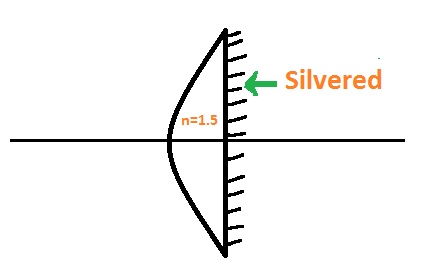
In a Plano-convex lens, the radius of curvature is $10cm$. If the plane side is silvered, then the focal length will be, (refractive index=1.5)
A. $20cm$
B. $10cm$
C. $15cm$
D. $5cm$
Answer
591.3k+ views
Hint: In a plano-convex lens, one of the sides is curved while the other side is flat. If the flat side is silvered, the lens will act as a concave mirror. The radius of curvature of a plane or flat surface is taken as infinite.
Complete Step-by-Step solution:

In our question, we are given a plano-convex lens which is silvered on the plane side. The radius of curvature of the curved side is given to be $10cm$. A plane convex lens which is silvered on one of the sides will act as a concave mirror. The effective focal length of this configuration is given by,
$\dfrac{1}{f}=\dfrac{2}{{{f}_{l}}}+\dfrac{1}{{{f}_{m}}}$….. equation (1)
Where,
${{f}_{l}}$ is the focal length of the non-silvered surface (curved surface in our case)
${{f}_{m}}$ is the focal length of the mirror (silvered surface)
So we know that the focal length of a mirror ${{f}_{m}}$ is half the radius of curvature of the mirror, so we can write ${{f}_{m}}=\dfrac{{{R}_{m}}}{2}$. Here in the case of a plane silvered surface the radius of curvature is very high and taken as infinity. So ${{f}_{m}}$ will also be infinity.
The focal length of a curved surface of a lens is given by the lens makers formula,
$\dfrac{1}{{{f}_{l}}}=\left( \mu -1 \right)\left( \dfrac{1}{R} \right)$
Where, $\mu $ is the refractive index of the lens material. R is the radius of curvature of the curved surface.
So substituting the values of ${{f}_{m}}$ and ${{f}_{l}}$ in equation (1), we get,
$\dfrac{1}{f}=\dfrac{2\left( \mu -1 \right)}{R}+\dfrac{1}{\infty }$
$\therefore \dfrac{1}{f}=\dfrac{2\left( \mu -1 \right)}{R}$
Substituting the values of refractive index and radius of curvature in the above equation, we get
$\dfrac{1}{f}=\dfrac{2\left( 1.5-1 \right)}{10}=\dfrac{2\times 0.5}{10}$
$\therefore f=10cm$
So the focal length of the plano convex lens silvered at the plane side and having a radius of curvature $10cm$ is $f=10cm$. (Option (B) )
Note: A light incident on a convex lens which is silvered experiences one reflection at the silvered side and two refractions at the non-silvered side.
If the plane surface had not been silvered, the focal length of the plano-convex lens would be 20cm.
The focal length of a lens increases when it is kept in a medium which has a refractive index higher than the refractive index of air. Example – A convex lens kept in water.
Complete Step-by-Step solution:

In our question, we are given a plano-convex lens which is silvered on the plane side. The radius of curvature of the curved side is given to be $10cm$. A plane convex lens which is silvered on one of the sides will act as a concave mirror. The effective focal length of this configuration is given by,
$\dfrac{1}{f}=\dfrac{2}{{{f}_{l}}}+\dfrac{1}{{{f}_{m}}}$….. equation (1)
Where,
${{f}_{l}}$ is the focal length of the non-silvered surface (curved surface in our case)
${{f}_{m}}$ is the focal length of the mirror (silvered surface)
So we know that the focal length of a mirror ${{f}_{m}}$ is half the radius of curvature of the mirror, so we can write ${{f}_{m}}=\dfrac{{{R}_{m}}}{2}$. Here in the case of a plane silvered surface the radius of curvature is very high and taken as infinity. So ${{f}_{m}}$ will also be infinity.
The focal length of a curved surface of a lens is given by the lens makers formula,
$\dfrac{1}{{{f}_{l}}}=\left( \mu -1 \right)\left( \dfrac{1}{R} \right)$
Where, $\mu $ is the refractive index of the lens material. R is the radius of curvature of the curved surface.
So substituting the values of ${{f}_{m}}$ and ${{f}_{l}}$ in equation (1), we get,
$\dfrac{1}{f}=\dfrac{2\left( \mu -1 \right)}{R}+\dfrac{1}{\infty }$
$\therefore \dfrac{1}{f}=\dfrac{2\left( \mu -1 \right)}{R}$
Substituting the values of refractive index and radius of curvature in the above equation, we get
$\dfrac{1}{f}=\dfrac{2\left( 1.5-1 \right)}{10}=\dfrac{2\times 0.5}{10}$
$\therefore f=10cm$
So the focal length of the plano convex lens silvered at the plane side and having a radius of curvature $10cm$ is $f=10cm$. (Option (B) )
Note: A light incident on a convex lens which is silvered experiences one reflection at the silvered side and two refractions at the non-silvered side.
If the plane surface had not been silvered, the focal length of the plano-convex lens would be 20cm.
The focal length of a lens increases when it is kept in a medium which has a refractive index higher than the refractive index of air. Example – A convex lens kept in water.
Recently Updated Pages
Master Class 10 General Knowledge: Engaging Questions & Answers for Success

Master Class 10 Science: Engaging Questions & Answers for Success

Master Class 10 Social Science: Engaging Questions & Answers for Success

Master Class 10 Maths: Engaging Questions & Answers for Success

Master Class 10 English: Engaging Questions & Answers for Success

Master Class 10 Computer Science: Engaging Questions & Answers for Success

Trending doubts
The shortest day of the year in India

10 examples of evaporation in daily life with explanations

A Gulab jamun contains sugar syrup up to about 30 of class 10 maths CBSE

What is UltraEdge (Snickometer) used for in cricket?

On the outline map of India mark the following appropriately class 10 social science. CBSE

Why does India have a monsoon type of climate class 10 social science CBSE




